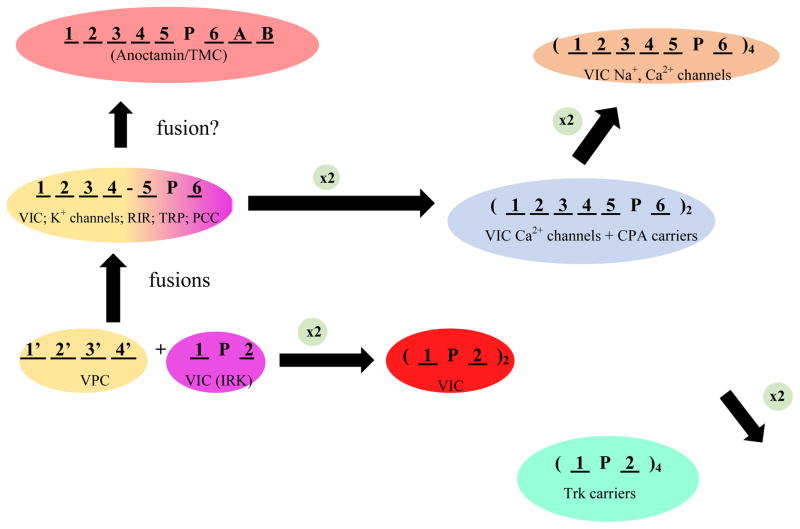Figure 2.
Proposed pathway for the diversification of the Volatge-gated Ion Channel (VIC) Superfamily. The two precursors of 6 TMS VIC family members were (1) a 4 TMS voltage-gated H+ channel (VPC, TC# 1.A.51; yellow, lower left) and (2) a 2 TMS plus pore loop (P) ion (K+) channel (VIC, TC# 1.A.1 and IRK 1.A.2; purple, lower left), which fused with the former N-terminal and the latter C-terminal, to give the voltage-sensor and the channel, respectively, of typical 6 TMS VIC channels (central left; yellow and purple, respectively). Some of these channels gained extra domains by domain fusion events yielding large proteins with the usual 6 TMS topology (RIR, TC# 1.A.3; TRP, TC# 1.A.4 and PCC, TC# 1.A.5). Both the resultant 6 TMS channel and the original 2 TMS channel sometimes duplicated to give 12 TMS proteins (blue; VIC Ca2+ channels; TC# 1.A.1.11) as well as monovalent cation:proton antiporters (blue; CPA; TC# 2.A.36 and TC# 2.A.37), and 4 TMS proteins (red; some VIC K+ channels, TC# 1.A.1.9), respectively (central and lower right, respectively). While the 6 and 2 TMS proteins must tetramerize to form an active channel, the duplicated 12 and 4 TMS VIC channels form active dimers. Most VIC family calcium channels (TC# 1.A.1.11) and possibly all such sodium channels (TC# 1.A.1.10) in animals underwent a second duplication event to form monomeric 24 TMS channel proteins with four 6 TMS internal repeats (brown; top right). In prokaryotes, characterized Na+ and Ca2+ channel proteins of the VIC family usually have 6 TMSs with the P-loop between TMSs 5 and 6, and they must tetramerize to form active channels (not shown). The anoctamin family (TC# 1.A.17; orange) may have arisen from the 6 TMS VIC-like proteins as shown (upper left), although the positions of the P-loops in these proteins are still controversial. Trk K+ carriers (TC #2.A.8) arose following quadruplication of the simple 2 TMS + P-loop unit (green; bottom left). Ion specificity in higher eukaryotes may have evolved via the pathway: K+→ Ca2+→ Na+.

